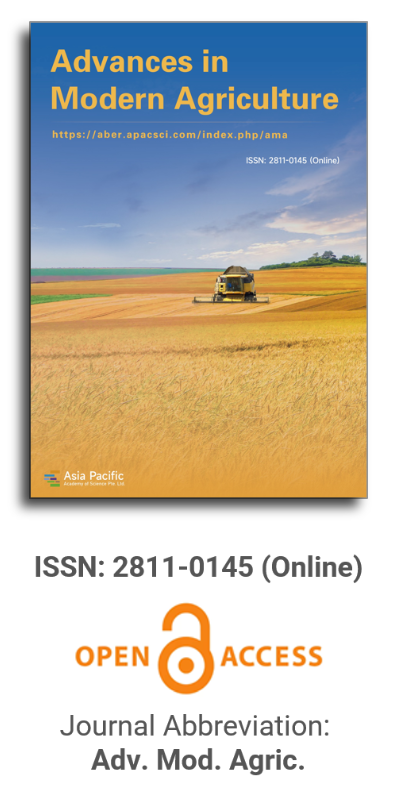


Regulation of modern "grass-sheep-field" agro-pastoral cycle system based on life cycle assessment
Vol 4, Issue 1, 2023
VIEWS - 3428 (Abstract)
Download PDF
Abstract
Keywords
References
- Li F J, Dong S C, Li F. A system dynamics model for analyzing the eco-agriculture system with policy recommendations[J]. Ecological Modeling, 2012, 227: 34-45.
- Donner M, Verniquet A, Broeze J, et al. Critical success and risk factors for circular business models valorising agricultural waste and by-products[J]. Resources, Conservation & Recycling, 2021, 165: 105236.
- Adegbeye M J, Ravi Kanth Reddy P, Obaisi A I, et al. Sustainable agriculture options for production, greenhouse gasses and pollution alleviation, and nutrient recycling in emerging and transitional nations-An overview[J]. Journal of Cleaner Production, 2020, 242: 118319.
- Xu Xiangbo, Sun Mingxing, Zhang Linxiu. Research progress of life cycle assessment on agriculture[J]. Acta Ecologica Sinica, 2021, 41(1): 422-433. (in Chinese with English abstract)
- Altieri M A. Agroecology: The Science of Sustainable Agriculture[M]. Boca Raton: CRC Press, 2018.
- Tricase C, Lamonaca E, Ingrao C, et al. A comparative life cycle assessment between organic and conventional barley cultivation for sustainable agriculture pathways[J]. Journal of Cleaner Production, 2018, 172: 3747-3759.
- Christensen L O, Galt R E, Kendall A. Life-cycle greenhouse gas assessment of Community Supported Agriculture in California's Central Valley[J]. Renewable Agriculture and Food Systems, 2018, 33(5): 393-405.
- Masuda K. Measuring eco-efficiency of wheat production in Japan: A combined application of life cycle assessment and data envelopment analysis[J]. Journal of Cleaner Production, 2016, 126: 373-381.
- Taki M, Soheili-Fard F, Rohani A, et al. Life cycle assessment to compare the environmental impacts of different wheat production systems[J]. Journal of Cleaner Production, 2018, 197: 195-207.
- Jimmy A N, Khan N A, Hossain M N, et al. Evaluation of the environmental impacts of rice paddy production using life cycle assessment: Case study in Bangladesh[J]. Modeling Earth Systems and Environment, 2017, 3(4): 1691-1705.
- Yang Xinglin, Liu Yanbing, Zhu Zongyuan, et al. Life cycle assessment of biodiesel from soybean oil and waste oil[J]. Transactions of the Chinese Society of Agricultural Engineering (Transactions of the CSAE), 2020, 36(19): 233-241. (in Chinese with English abstract)
- Bai Jinheng. Ecological Environment Impacts and Driving Mechanisms of Rice Production in Liaoning[D]. Shenyang: Shenyang Agricultural University, 2020. (in Chinese with English abstract)
- Chen Zhongdu, Li Fengbo, Feng Jinfei, et al. Study on carbon footprint for rice-wheat rotation system in the lower reaches of Yangtze River: Based on the life cycle assessment[J]. Chinese Journal of Agricultural Resources and Regional Planning, 2019, 40(12): 81-90. (in Chinese with English abstract)
- Liang Long, Chen Yuanquan, Gao Wangsheng. Integrated evaluation of circular agriculture system: A life cycle perspective[J]. Environmental Science, 2010, 31(11): 2795-2803. (in Chinese with English abstract)
- Zhang X, Ma F, Wang L. Application of life cycle assessment in agricultural circular economy[J]. Applied Mechanics and Materials, 2013, 260/261: 1086-1091.
- Wang X L, Dadouma A, Chen Y, et al. Sustainability evaluation of the large-scale pig farming system in North China: An emergy analysis based on life cycle assessment[J]. Journal of Cleaner Production, 2015, 102: 144-164.
- Fan W, Dong X, Wei H, et al. Is it true that the longer the extended industrial chain, the better the circular agriculture? A case study of circular agriculture industry company in Fuqing, Fujian[J]. Journal of Cleaner Production, 2018, 189: 718-728.
- Dorr E, Koegler M, Gabrielle B, et al. Life cycle assessment of a circular, urban mushroom farm[J]. Journal of Cleaner Production, 2021, 288: 125668.
- Bakshi B R. A thermodynamic framework for ecologically conscious process systems engineering[J]. Computers & Chemical Engineering, 2002, 26(2): 269-282.
- Ulgiati S, Brown M T. Quantifying the environmental support for dilution and abatement of process emissions: the case of electricity production[J]. Journal of Cleaner Production, 2002, 10(4): 335-348.
- Jiangsu Taihu Institute of Agricultural Sciences. Modern "grass-sheep-field" agricultural and animal husbandry cycle production technology [J]. Jiangsu Agricultural Science, 2017, 45(24): 6.
- Guinée J B. Handbook on Life Cycle Assessment: Operational Guide to the ISO Standards[M]. Dordrecht: Kluwer Academic Publishers, 2002.
- Moreno Ruiz E, FitzGerald D, Symeonidis A, et al. Technical report of changes implemented in the ecoinvent database between v3.7 & v3.7.1[R]. Zürich: Ecoinvent Association, 2020.
- Ciroth A, Di Noi C, Lohse T, et al. OpenLCA 1. 10 comprehensive user manual[R]. Berlin: GreenDelta, 2020.
- Van Oers L. CML-IA database, characterisation and normalisation factors for midpoint impact category indicators[EB/OL]. (2016-09-05)[2020-08-15]. http: //www. cml. leiden. edu/software/data-cmlia. html.
- United Nations, Department of Economic and Social Affairs, Population Division. World Population Prospects 2019[EB/OL]. (2020-05-01)[2020-09-14]. https: //population. un. org/wpp/Download/Standard/Population/.
- Wang M, Wu W, Liu W, et al. Life cycle assessment of the winter wheat-summer maize production system on the North China Plain[J]. The International Journal of Sustainable Development & World Ecology, 2007, 14(4): 400-407.
- Liang Long. Environmental Impact Assessment of Circular Agriculture Based on Life Cycle Assessment: Methods and Case Studies[D]. Beijing: China Agricultural University, 2009. (in Chinese with English abstract)
- Wang Xiaolong. An Integrated Framework Based on Life Cycle Assessment and Emergy Evaluation for Circular Agriculture: Theories, Methods and Cases[D]. Beijing: China Agricultural University, 2016. (in Chinese with English abstract)
- Mi Lan. Microbial Underpinning of the Differential Methane Emission Between Hu Sheep and New Zealand White rabbits[D]. Hangzhou: Zhejiang University, 2018. (in Chinese with English abstract)
- Li Danyang, Ma Ruonan, Qi Chuanren, et al. Effects of moisture content on maturity and pollution gas emissions during sheep manure composting[J]. Transactions of the Chinese Society of Agricultural Engineering (Transactions of the CSAE), 2020, 36(20): 254-262. (in Chinese with English abstract)
- State Environmental Protection Administration. HJ/T332—2006, Environmental Quality Evaluation Standards for Edible Agricultural Products [S]. Beijing: China Environmental Science Press, 2007.
- Ministry of Environmental Protection of the People's Republic of China. HJ568—2010, Specification for Environmental Assessment of Livestock and Poultry Breeding Places [S]. Beijing: China Environmental Science Press, 2010.
- Ministry of Environmental Protection of the People's Republic of China. HJ25. 3—2014, Technical Guidelines for Risk Assessment of Contaminated Sites [S]. Beijing: China Environmental Science Press, 2014.
- General Administration of Quality Supervision, Inspection and Quarantine of the People's Republic of China. GB18468-2001, Hygienic Standard for Paradichlorobenzene in Indoor Air [S]. Beijing: China Standard Press, 2002.
- State Environmental Protection Administration. GB8978—1996, Integrated Wastewater Discharge Standard [S]. Beijing: China Environmental Science Press, 1996.
Supporting Agencies
Copyright (c) 2022 Yuan Shen, Haihou Wang, Yueyue Tao, Changying Lu, Linlin Dong, Linlin Shi, Meijuan Jin, Xinwei Zhou, Mingxing Shen

This work is licensed under a Creative Commons Attribution-NonCommercial 4.0 International License.

This site is licensed under a Creative Commons Attribution 4.0 International License (CC BY 4.0).

Prof. Zhengjun Qiu
Zhejiang University, China

Cheng Sun
Academician of World Academy of Productivity Science; Executive Chairman, World Confederation of Productivity Science China Chapter, China
Indexing & Archiving
In the realm of modern agriculture, the integration of cutting-edge technologies is revolutionizing the way we approach sustainable farming practices. A recent study published in Advances in Modern Agriculture titled "Classification of cotton water stress using convolutional neural networks and UAV-based RGB imagery" has garnered significant attention for its innovative approach to precision irrigation management. Conducted by researchers from Institute of Data Science and the AgriLife Research and Extension Center of Texas A&M University (authors's information is below). This study introduces a novel method for classifying cotton water stress using unmanned aerial vehicles (UAVs) and convolutional neural networks (CNNs), offering a powerful solution for optimizing water use in agriculture.
Modern agricultural technology is evolving rapidly, with scientists collaborating with leading agricultural enterprises to develop intelligent management practices. These practices utilize advanced systems that provide tailored fertilization and treatment options for large-scale land management.
This journal values human initiative and intelligence, and the employment of AI technologies to write papers that replace the human mind is expressly prohibited. When there is a suspicious submission that uses AI tools to quickly piece together and generate research results, the editorial board of the journal will reject the article, and all journals under the publisher's umbrella will prohibit all authors from submitting their articles.
Readers and authors are asked to exercise caution and strictly adhere to the journal's policy regarding the usage of Artificial Intelligence Generated Content (AIGC) tools.
Asia Pacific Academy of Science Pte. Ltd. (APACSCI) specializes in international journal publishing. APACSCI adopts the open access publishing model and provides an important communication bridge for academic groups whose interest fields include engineering, technology, medicine, computer, mathematics, agriculture and forestry, and environment.



.jpg)
.jpg)

.jpg)
